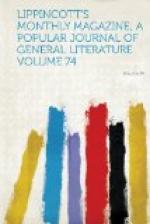In Salem street, Boston, left almost alone at the extreme north end of the city, is Christ Church, built in 1723. Its tower contains the oldest chime of bells in America, and from it, according to some antiquarians, was hung the lantern which on April 18, 1775, announced to the waiting Paul Revere, and through him to the Middlesex patriots in all the surrounding country, that General Gage had despatched eight hundred men to seize and destroy the military stores gathered at Concord by the Massachusetts Committees of Safety and Supplies. Thus opened the Revolutionary war, for the battles at Lexington and Concord took place only the next day.
The white-spired building at the corner of Park and Tremont streets, Boston, known as the Park Street Church, is hardly so old as its extended fame would lead one to suppose, for it dates no farther back than the first quarter of the present century. Its position as the central point of the great theological controversies of 1820 in the Congregational churches of Eastern Massachusetts has made it almost as familiar as the “Saybrook Platform.” The meeting-house was built at the time when the greater part of the Boston churches were modifying their creeds, and when the Old South itself would have changed its denominational relations but for the vote of a State official, cast to break a tie. Its inelegance and rawness are excused in part by its evident solidity and sincerity of appearance. In its shadow rest Faneuil, Revere, Samuel Adams and John Hancock.
Boston has other churches which, like the Park Street, are neither ancient nor modern, the Hollis Street Church and the First Church in Roxbury being good examples. New England has hardly a better specimen of the old-fashioned meeting-house on a hill than this old weather-beaten wooden First Church in Roxbury, the home of a parish to which John Eliot, the apostle to the Indians, once ministered. Another quaint memorial of the old colonial days survives in the current name, “Meeting-house Hill,” of a part of the annexed Dorchester district of Boston.
[Ilustration: ST. PAUL’S CHAPEL, NEW YORK.]
St. Paul’s Church, on Boston Common, was the first attempt of the Episcopalians of the city, after the loss of King’s Chapel, to build a temple of imposing appearance. Controversies theological and architectural rose with its walls, and young Edward Everett, if report is to be credited, was the author of a tract, still in circulation, in which its design and its principles formed the text for a criticism on the religion to whose furtherance it was devoted. Standing as it does next the United States court-house, the uses of the two buildings seem to have been confused in the builders’ minds; for there is something ecclesiastical in the appearance of the hall of justice, which was originally a Masonic temple, and something judicial in the face of the church.




